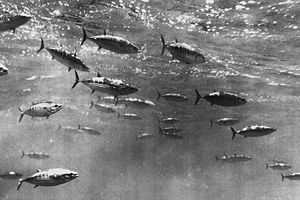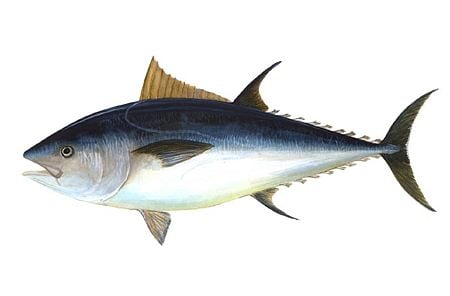Difference between revisions of "Tuna" - New World Encyclopedia
Glenn Strait (talk | contribs) |
Glenn Strait (talk | contribs) |
||
| Line 13: | Line 13: | ||
Members of the Scombridae family have two dorsal fins with 5 to 12 finlets behind the second dorsal and the anal fins (Nelson 1994). The first dorsal fin has 9 to 27 rays, the pelvic fins have six rays and are placed behind the pectoral fins, which are high on the body (Nelson 1994). Tunas have a deeply forked or crescent-shaped tail, and the body is very narrow right before the tail. | Members of the Scombridae family have two dorsal fins with 5 to 12 finlets behind the second dorsal and the anal fins (Nelson 1994). The first dorsal fin has 9 to 27 rays, the pelvic fins have six rays and are placed behind the pectoral fins, which are high on the body (Nelson 1994). Tunas have a deeply forked or crescent-shaped tail, and the body is very narrow right before the tail. | ||
| − | Tunas range in size from the bullet tuna (''Auxus rochei eudorax''), which reaches one-half a meter in maximum size, to the Northern bluefin tuna (''Thunnus | + | Tunas range in size from the bullet tuna (''Auxus rochei eudorax''), which reaches one-half a meter in maximum size, to the Northern bluefin tuna (''Thunnus thynnus''), which reaches 4.6 meters (15 feet) in maximum size and up to 800 kilograms (1,760 pounds). The commercially important false albacore or "little tunafish" (''Euthynnus alletteratus'') reaches a maximum size of about 1.2 meters (4 feet) and averages about 4.5 kilograms (9.9 pounds). |
Tunas are found in temperate and tropical marine waters worldwide, being common in the Pacific Ocean and Atlantic Ocean, but also found in the Mediterranean Sea, Black Sea, and elsewhere. Pacific bluefin tuna spawn in the Western Pacific between Okinawa and the [[Philippines]] and probably the Sea of Japan/East Sea, then migrate over 6,000 nautical miles (11,100 km) to the Eastern Pacific, and eventually return to their birth waters to spawn again. | Tunas are found in temperate and tropical marine waters worldwide, being common in the Pacific Ocean and Atlantic Ocean, but also found in the Mediterranean Sea, Black Sea, and elsewhere. Pacific bluefin tuna spawn in the Western Pacific between Okinawa and the [[Philippines]] and probably the Sea of Japan/East Sea, then migrate over 6,000 nautical miles (11,100 km) to the Eastern Pacific, and eventually return to their birth waters to spawn again. | ||
| Line 57: | Line 57: | ||
* Little tunny (little tunafish) ''Euthynnus alletteratus'' | * Little tunny (little tunafish) ''Euthynnus alletteratus'' | ||
| − | Two | + | Two others outside the tribe Thunnini are sometimes considered tunas: |
* Butterfly kingfish (Butterfly mackerel) ''Gasterochisma melampus'' <small>Richardson, 1845</small> | * Butterfly kingfish (Butterfly mackerel) ''Gasterochisma melampus'' <small>Richardson, 1845</small> | ||
| Line 66: | Line 66: | ||
[[Image:tuna steak.JPG|thumb|right|200px|Tuna steak served in a French bistro.]] | [[Image:tuna steak.JPG|thumb|right|200px|Tuna steak served in a French bistro.]] | ||
| − | Tuna | + | Tuna has been an important commercial fish for centuries. It was first canned in 1903 and is now probably the most popular fish for canning. The best known tunas for canning are the albacore, bluefin, and yellowfin, with the high-fat albacore also having the lightest color flesh and being the only tuna whose meat can be called "white," being white with a hint of pink. Yellowfin tunas have a slightly stronger flavor than albacore and has pale pink flesh (labeled "light" not "white")###. Bluefin tunas are the largest tunas. Young bluefin tunas have a lighter and less strongly flavored flesh than the adult bluefins, whose flesh is dark red. (Herbst 2001) |
In addition to its major use for canning, tuna is sold as steaks, fillets, and as sashimi. The northern bluefin tuna is an important food fish used almost exclusively for sashimi and sushi. Canned tuna is precooked, and packed in either water or oil, and sold in the three grades of flaked or grated (bits and pieces), chunk (small pieces), and solid or fancy (large pieces) (Herbst 2001). | In addition to its major use for canning, tuna is sold as steaks, fillets, and as sashimi. The northern bluefin tuna is an important food fish used almost exclusively for sashimi and sushi. Canned tuna is precooked, and packed in either water or oil, and sold in the three grades of flaked or grated (bits and pieces), chunk (small pieces), and solid or fancy (large pieces) (Herbst 2001). | ||
Revision as of 13:22, 2 August 2007
Tuna is any of 14 species of ocean-dwelling fish comprising the tribe Thunnini in the family Scombridae (the mackeral family). The 14 species are collected into five genera—Thunnus, Euthynnus, Allothunnus, Auxis, and Katsuwonus (Nelson 1994). Tuna is also the name of the commercial food from these species.
Tunas are fast-swimming fish spread widely through the world's oceans and seas. Some species travel great distances and some, whose members are able to raise their body temperature significantly above the temperature of the surrounding water, forage through a wide range of water temperature regimes.
Tuna are important in food chains, consuming fish, plankton, and mollusks, and being consumed by sharks, rays, billfishes, larger tunas, and toothed whales. They are also important to human beings for food and for sport fishing. Tuna meat is very popular both canned and raw (as sashimi and for making sushi).
Tuna's place in the food chain as both predator and prey demonstrates the important principle of dual purposes: each individual tuna pursues its individual purposes of survival, maintenance, and reproduction, while it also fulfills a whole purpose by providing value to the ecosystem. Beyond the natural ecosystem, tuna fulfills a higher whole purpose by providing food and recreation for humans. In return, humans, in principle, should exercise responsible stewardship of the tuna fisheries. The reality, instead, is that humans are overfishing some tuna species to the extent of pushing a few of those fisheries close to what appears to be the brink of collapse.
Description
Members of the Scombridae family have two dorsal fins with 5 to 12 finlets behind the second dorsal and the anal fins (Nelson 1994). The first dorsal fin has 9 to 27 rays, the pelvic fins have six rays and are placed behind the pectoral fins, which are high on the body (Nelson 1994). Tunas have a deeply forked or crescent-shaped tail, and the body is very narrow right before the tail.
Tunas range in size from the bullet tuna (Auxus rochei eudorax), which reaches one-half a meter in maximum size, to the Northern bluefin tuna (Thunnus thynnus), which reaches 4.6 meters (15 feet) in maximum size and up to 800 kilograms (1,760 pounds). The commercially important false albacore or "little tunafish" (Euthynnus alletteratus) reaches a maximum size of about 1.2 meters (4 feet) and averages about 4.5 kilograms (9.9 pounds).
Tunas are found in temperate and tropical marine waters worldwide, being common in the Pacific Ocean and Atlantic Ocean, but also found in the Mediterranean Sea, Black Sea, and elsewhere. Pacific bluefin tuna spawn in the Western Pacific between Okinawa and the Philippines and probably the Sea of Japan/East Sea, then migrate over 6,000 nautical miles (11,100 km) to the Eastern Pacific, and eventually return to their birth waters to spawn again.
Tunas are fast swimmers, having been clocked at 77 kilometers per hour (46 miles per hour). One of the important physiological adaptations that enhances their ability to swim so fast is a heat exchange system that keeps the swimming muscles warm by conserving heat when outgoing veins carrying warm, carbon dioxide-laden blood toward the gills pass the heat over to incoming arteries carrying cold oxygenated blood from the gills. By this method, tunas, as well as certain other fish species, maintain elevated body temperatures to varying degrees.
The bluefin tuna’s heat exchange system works to well that it can elevate the bluefin’s body temperatures to more that 20°C above ambient water temperatures. Generating and sustaining elevated body temperatures in general allows fish to be active in colder waters and to have enhanced swimming ability. This is in contrast to most fish, which are cold-blooded (poikilothermic), meaning that they do not maintain constant internal temperatures and instead their body temperature often mirrors the ambient temperature.
Unlike most fish species, whose flesh is white, the tunas generally have pink to dark red flesh due to elevated levels of myoglobin, a oxygen-binding molecule. The high concentrations of myoglobin in muscle tissue are another important factor supporting the tunas' ability to swim at high speeds. Tunas are important not only commercially, but also as sports fish, especially the bluefin tuna. Skipjack tunas, which can weigh up to 40 pounds, but are generally 6 to 8 pounds, are also known as Arctic bonito and oceanic bonito and get their name because of a seeming ability to "skip" out of the water (Herbst 2001).
Species
| Katsuwonus genus | ||||||||||||||
|---|---|---|---|---|---|---|---|---|---|---|---|---|---|---|
 Skipjack tuna, Katsuwonus pelamis
| ||||||||||||||
| Scientific classification | ||||||||||||||
|
There are eight tuna species in the Thunnus genus:
- Albacore, Thunnus alalunga (Bonnaterre, 1788).
- Yellowfin tuna, Thunnus albacares (Bonnaterre, 1788).
- Blackfin tuna, Thunnus atlanticus (Lesson, 1831).
- Southern bluefin tuna, Thunnus maccoyii (Castelnau, 1872).
- Bigeye tuna, Thunnus obesus (Lowe, 1839).
- Pacific bluefin tuna, Thunnus orientalis (Temminck & Schlegel, 1844).
- Northern bluefin tuna, Thunnus thynnus (Linnaeus, 1758).
- Longtail tuna, Thunnus tonggol (Bleeker, 1851).
Species of several other genera (all in the family Scombridae) have common names containing "tuna" and are part of the tribe Thunnini:
- Skipjack tuna Katsuwonus pelamis (Linnaeus, 1758)
- Slender tuna Allothunnus fallai Serventy, 1948
- Bullet tuna Auxis rochei rochei
- Frigate tuna Auxis thazard thazard
- Kawakawa (little tunafish or mackerel tunafish) Euthynnus affinis (Cantor, 1849)
- Little tunny (little tunafish) Euthynnus alletteratus
Two others outside the tribe Thunnini are sometimes considered tunas:
- Butterfly kingfish (Butterfly mackerel) Gasterochisma melampus Richardson, 1845
- Dogtooth tuna Gymnosarda unicolor (Rüppell, 1836)
Commercial importance
Tuna has been an important commercial fish for centuries. It was first canned in 1903 and is now probably the most popular fish for canning. The best known tunas for canning are the albacore, bluefin, and yellowfin, with the high-fat albacore also having the lightest color flesh and being the only tuna whose meat can be called "white," being white with a hint of pink. Yellowfin tunas have a slightly stronger flavor than albacore and has pale pink flesh (labeled "light" not "white")###. Bluefin tunas are the largest tunas. Young bluefin tunas have a lighter and less strongly flavored flesh than the adult bluefins, whose flesh is dark red. (Herbst 2001)
In addition to its major use for canning, tuna is sold as steaks, fillets, and as sashimi. The northern bluefin tuna is an important food fish used almost exclusively for sashimi and sushi. Canned tuna is precooked, and packed in either water or oil, and sold in the three grades of flaked or grated (bits and pieces), chunk (small pieces), and solid or fancy (large pieces) (Herbst 2001).
Tuna is a good source of lean protein, vitamins, minerals, and omega-3 fatty acids (USTF 2006), and can lower blood pressure and cholesterol. Omega-3 fatty acids have been shown to lower the risk of heart disease, ease the pain of arthritis, and reduce asthma complications (USTF 2006).
According to Foodmarket Exchange, the total tuna catch in 2000 stood at 3,605,000 tons, down about 5.7 percent from 3,823,000 tons in 1999. The main tuna catching nations are concentrated in Asia, with Japan and Taiwan as the main producers. Other important tuna catching nations in Asia are Indonesia and South Korea. Spain and France also are important tuna fishing countries, mainly catching in the Indian Ocean.
Japan remains the main nation fishing for tuna in the Pacific. In 2000, total tuna caught by Japanese vessels stood at 633,000 tons, about 17 percent of the world tuna catch. Taiwan was the second biggest tuna producer at 435,000 tons, or about 12 percent of the total tuna catch. Spain supplies most of the yellowfin to European canneries, accounting for 5.9 percent of the total tuna catch, while Ecuador and Mexico dominate the Eastern Pacific Ocean.
Increasing quantities of high-grade tuna are entering the market from operations that rear tuna in net pens and feed them on a variety of bait fish. In Australia, the southern bluefin tuna, Thunnus maccoyii, is one of two species of bluefin tunas that are kept in tuna farms. Its close relative, the northern bluefin tuna, Thunnus thynnus, is being used to develop tuna farming industries in the Mediterranean, North America, and Japan.
Due to their high position in the food chain and the subsequent accumulation of heavy metals from their diet, mercury levels can be relatively high in some of the larger species of tuna, such as bluefin and albacore. As a result, in March 2004, the United States Food and Drug Administration (FDA) issued guidelines recommending pregnant women, nursing mothers, and children limit their intake of tuna and other types of predatory fish (USDHHS 2004). They noted, for example, that albacore ("white") tuna has more mercury than canned light tuna. Most canned light tuna is skipjack tuna, which is lower in mercury. The Eastern Little Tuna (Euthynnus affinis) has recently come to market as a low-mercury, less expensive substitute for canned albacore.
Management and conservation
Some varieties of tuna, such as the bluefin and bigeye tuna, Thunnus obesus, are threatened by overfishing, which has dramatically affected tuna populations in the Atlantic and northwestern Pacific Oceans. Other populations seem to support fairly healthy fisheries (for example, the central and western Pacific skipjack tuna, Katsuwonus pelamis).
There is mounting evidence that the accumulation of excess harvesting capacity threatens tuna fisheries worldwide. Furthermore, international agreement regulations in catch limits and size of nets (no larger than 2.4 kilometers or 1.5 miles) are not always observed. The Australian Government alleged in 2006, for example, that Japan had illegally overfished southern bluefin for years. At a meeting of the Commission for the Conservation of Southern Bluefin Tuna in 2006, the Japanese delegation admitted that the country caught the southern bluefin tuna by some 1,800 tons more than its 6,065-ton quota in 2005 and agreed to a halving of its quota to 3,000 tons per year for the five years beginning in 2007. [1]
The bluefin tuna of all three species—northern, southern, and Pacific—are overfished throughout the world. They are hooked on longlines or illegally netted everywhere they swim, and many young bluefins are captured before they reproduce. Creating effective fishing policies for bluefin tuna is difficult since they are highly mobile and swim through the territorial waters of many different nations.
Use of drift nets also captures seals, dolphins, whales, and birds. Many tuna species, such as yellowfin tuna, associate with dolphins, swimming along side them, with dolphins being caught by fishermen seeking tuna. Tuna species that do not normally associate with dolphins include albacore and skipjack. Methods of fishing tuna have become more "dolphin friendly," becoming less prone to entangle, injure, or kill dolphins. However, there is no universal independent inspection program or verification of "dolphin safeness" to show that dolphins are not harmed during tuna fishing. According to the Consumers Union, this gives the claims such as "dolphin safe" little credibility.
There are 5 main tuna fishery management bodies. The five are the Western Central Pacific Ocean Fisheries Commission, the Inter-American Tropical Tuna Commission, the Indian Ocean Tuna Commission, the International Commission for the Conservation of Atlantic Tunas, and the Commission for the Conservation of Southern Bluefin Tuna.
ReferencesISBN links support NWE through referral fees
- ↑ Japan Admits to Overfishing Southern Bluefin TunaRetrieved July 31, 2007
- Clover, C. 2004. The End of the Line: How Overfishing is Changing the World and What We Eat. London: Ebury Press. ISBN 0091897807.
- Collette, B. B., and C. E. Nauen. 1983. Scombrids of the World: An Annotated and Illustrated Catalogue of Tunas, Mackerels, Bonitos, and Related Species Known to Date. FAO species catalogue, v. 2. Rome: United Nations Development Programme. ISBN 9251013810.
- Herbst, S. T. 2001. The New Food Lover's Companion: Comprehensive Definitions of Nearly 6,000 Food, Drink, and Culinary Terms. Barron's Cooking Guide. Hauppauge, NY: Barron's Educational Series. ISBN 0764112589.
- Nelson, J. S. 1994. Fishes of the World, 3rd ed. New York: John Wiley & Sons. ISBN 0471547131.
- U.S. Department of Health and Human Services and the U.S. Environmental Protection Agency (USDHHS). 2004. What you need to know about mercury in fish and shellfish. EPA-823-R-04-005. Retrieved April 28, 2007.
- U.S. Tuna Foundation (USTF). 2006. Health benefits. U. S. Tuna Foundation. Retrieved April 28, 2007.
External links
- The Sushi FAQ: Tuna use in sushi: akami & toro. Retrieved April 29, 2007.
Credits
New World Encyclopedia writers and editors rewrote and completed the Wikipedia article in accordance with New World Encyclopedia standards. This article abides by terms of the Creative Commons CC-by-sa 3.0 License (CC-by-sa), which may be used and disseminated with proper attribution. Credit is due under the terms of this license that can reference both the New World Encyclopedia contributors and the selfless volunteer contributors of the Wikimedia Foundation. To cite this article click here for a list of acceptable citing formats.The history of earlier contributions by wikipedians is accessible to researchers here:
The history of this article since it was imported to New World Encyclopedia:
Note: Some restrictions may apply to use of individual images which are separately licensed.



